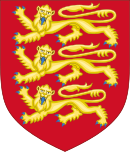This article needs to be updated. (April 2020) |
| Regions of England | |
|---|---|
 | |
| Category |
|
| Location | England |
| Created |
|
| Number | |
| Additional status |
|
| Populations | 2,669,941–9,180,135 |
| Areas | 1,572–23,836 km2 |
| Government |
|
| Subdivisions |
|
| This article is part of a series within the Politics of the United Kingdom on the |
 |
|---|
The regions of England, formerly known as the government office regions, are the highest tier of sub-national division in England. They were established in 1994[1] and follow the 1974–96 county borders. They are a continuation of the former 1940s standard regions which followed the 1889–1974 administrative county borders. Between 1994 and 2011, all nine regions had partly devolved functions; they no longer fulfil this role, continuing to be used for limited statistical purposes.[2]
While the UK was a member of the European Union, they defined areas (constituencies) for the purposes of elections to the European Parliament. Eurostat also used them to demarcate first level Nomenclature of Territorial Units for Statistics (NUTS) regions ("NUTS 1 regions") within the European Union, which in 2021 were superseded by International Territorial Level (ITL) regions ("ITL 1 regions").
The London Region has a directly elected Mayor and Assembly. Six regions have local authority leaders' boards to assist with correlating the headline policies of local authorities. The remaining two regions no longer have any administrative functions, having abolished their regional local authority leaders' boards.
In 1998, regional chambers were established in the eight regions outside London, which produced strategic plans and recommendations to local authorities. Each of the regions also had an associated (central) Government Office with some responsibility for coordinating policy, and, from 2007, a part-time regional minister within the Government. House of Commons regional Select Committees were established in 2009. However, the chambers and select committees were abolished in May 2010, restoring these functions to the main tier of local government,[3] with limited functions transferred to the regional local authority leaders' boards created in 2009. Regional ministers were not reappointed by the incoming Coalition Government, and the Government Offices were abolished in 2011.
From 2011, combined authorities have been introduced in some city regions, with similar responsibilities to the former regional chambers (and in some cases, replacing a regional local authority leaders' board on a smaller scale), but which also receive additional delegated functions from central government relating to transport and economic policy.
Regional development agencies were public bodies established in all nine regions in 1998 to promote economic development. They had certain delegated functions, including administering European Union regional development funds, and received funding from the central government as well. These were abolished in 2012, with statutory functions returning to local authorities and central government; however, smaller scale local enterprise partnerships were voluntarily established to take on some functions relating to coordinating economic priorities and development.
- ^ Local government geography and history, Department for Communities and Local Government. Retrieved 23 November 2016.
- ^ "A Beginners Guide to UK Geography (2023)". Open Geography Portal. Office for National Statistics. 24 August 2023. Retrieved 9 December 2023.
- ^ "House of Commons Hansard Debates for 27 May 2010 (pt 0001)". Publications.parliament.uk. 27 May 2010. Retrieved 24 November 2010.